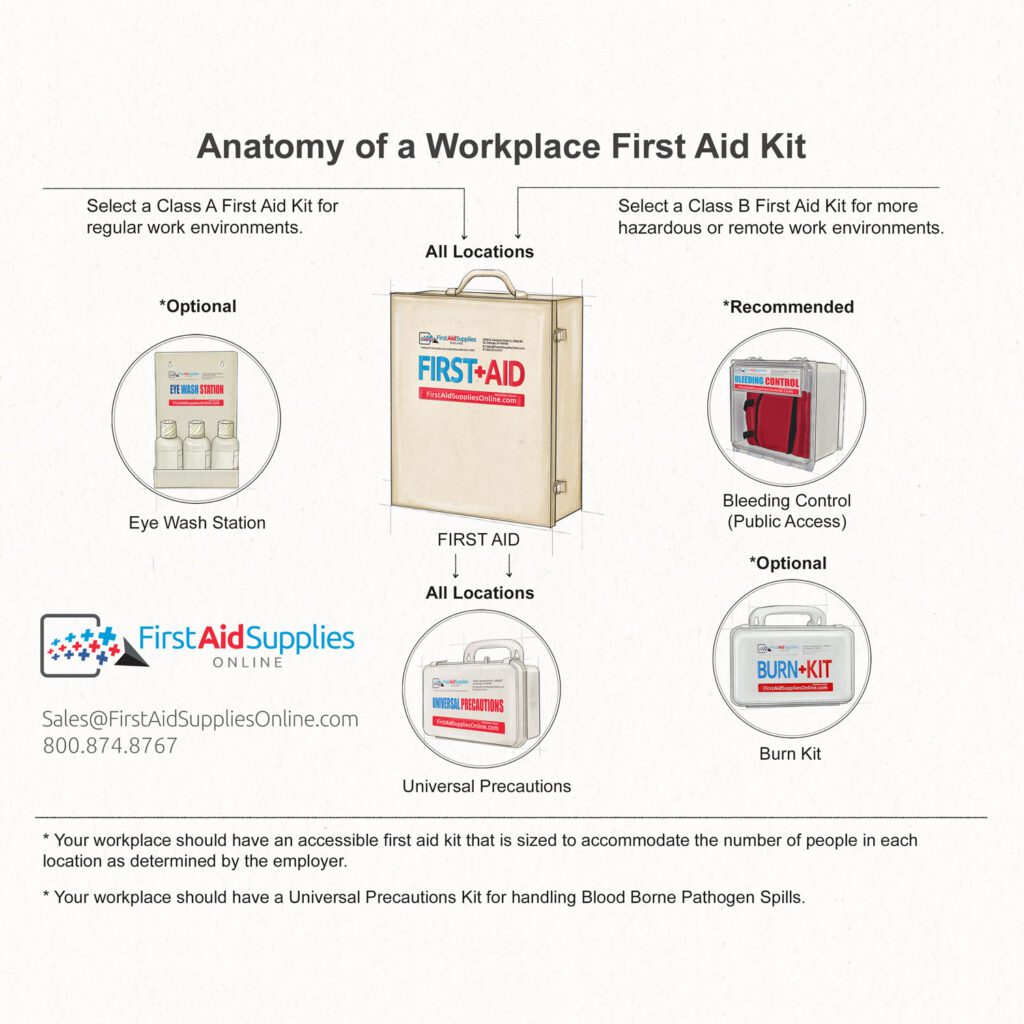Your cart is currently empty!
Industrial First Aid Kits: A Detailed Guide for Businesses

Identifying Your Business’s First Aid Kit Needs: The Starting Point
Embarking on the journey to equip the right industrial first aid kit for your business begins with understanding your specific requirements. This initial step involves checking with your state’s regulations and determining if there are unique needs within your business context. While some states may not impose specific guidelines, others adhere to the ANSI standard. Identifying these criteria will help you decide on the size, quantity, and type of kits required, whether it’s Class A, Class B, or a combination of both.
Keeping Up with ISEA Recommendations and ANSI Standards
Staying current and compliant is crucial in any workplace safety endeavor. Adhering to the latest ANSI/ISEA Z308.1-2021 standard means ensuring you have the recommended supplies readily available for your employees. It’s not just about meeting legal requirements but ensuring the well-being and safety of your team.
Class A First Aid Kits: The Standard for Most Businesses
For many businesses, a Class A First Aid Kit suffices. These kits encompass the essentials required for typical workplace injuries. They contain the minimum recommended quantities and additional supplies commonly used in various work environments. Options are available with or without tablets to cater to different business preferences.
Class B First Aid Kits: Tailored for Higher-Risk Environments
Businesses operating in hazardous environments or in locations where emergency services face delays should consider Class B first aid kits. These kits include additional items like tourniquets and splints, designed for more serious injuries. It’s vital to have personnel trained in using these advanced medical tools to ensure they are employed effectively and safely.
Expanding the Range of Class B Kits
Recognizing the diverse needs of different work environments, a range of Class B First Aid Kits is available. This variety includes options with or without tablets, responder bag kits, rugged waterproof kits, and basic versions containing just the essentials. The Class B Deluxe kit, for instance, is fully stocked with a wide assortment of supplies, going beyond the minimum requirements.
Introducing the Large Class B Red Rugged First Aid Kit
Recently, the lineup has expanded to include the Large Class B Red Rugged First Aid Kit, specifically designed for larger groups or those working in more hazardous settings like construction sites, boats, and barges, or outdoor industrial areas. This addition underscores the commitment to providing solutions for all types of work scenarios.
Determining the Right Size for Your First Aid Kits
Choosing the correct size for your first aid kit is not a one-size-fits-all decision. The industry type, frequency of injuries, and the nature of potential accidents play a crucial role in this choice. Generally, first aid in workplaces caters to everyday injuries like cuts, bruises, and sprains, but also needs to account for more severe incidents.
Calculating the Number of First Aid Kits Needed
The size of your facility and the number of employees working in each area will dictate how many first aid kits you should purchase. For example, a large multi-level warehouse with hundreds of employees may require different kits for various areas like offices, manufacturing floors, or vehicles. It’s essential to ensure easy accessibility and regular maintenance of these kits.
The Importance of Blood Borne Pathogen Kits
An often overlooked but critical component is the Blood Borne Pathogen Kit, mandated by OSHA. These kits play a vital role in safely managing bodily fluid spills and should be placed in accessible locations. Equipped with comprehensive instructions, they are an indispensable part of workplace safety.
Maintaining and Inventorying Your First Aid Supplies
Regular inventory checks and maintenance of your first aid kits are as crucial as having the kits themselves. This process includes ensuring all recommended supplies are available, checking expiration dates, and understanding the specific needs of your workplace. We offer a handy inventory worksheet to simplify this process, making reordering a breeze and ensuring your kits are always fully stocked and up to date.
Benefits of Managing Your Own First Aid Kits
While some businesses may opt for external services to manage their first aid supplies, there are significant benefits to doing it in-house. This approach gives you complete control over the contents of your kits, allows for tailored solutions to your specific needs, and can be more cost-effective. If you have trained personnel, assigning them the responsibility of maintaining the kits ensures continuous readiness and compliance.
Conclusion
Equipping your business with the appropriate industrial first aid kits is a crucial aspect of workplace safety. By understanding and adhering to state and federal regulations, assessing the specific needs of your work environment, and choosing the right type and size of kits, you can ensure a safe and prepared workplace. Regular maintenance and inventory checks will keep your kits ready for any emergency, while managing your own supplies offers flexibility and cost savings. Safety in the workplace is a continuous commitment, and having the right first aid equipment is a significant step towards fulfilling this responsibility.
